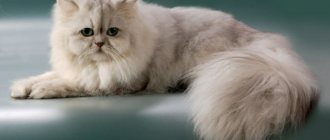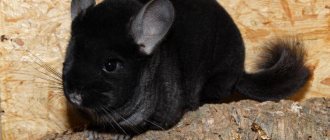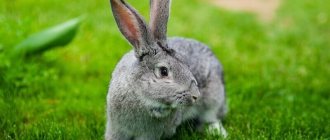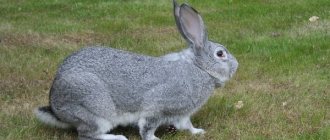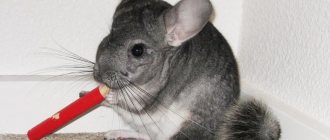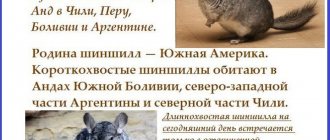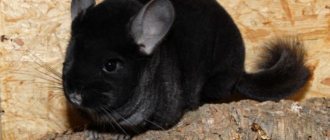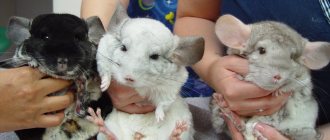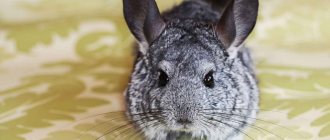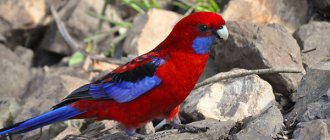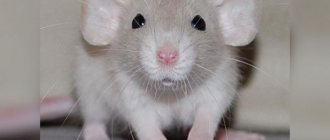Many members of the older generation became acquainted with the chinchilla cat thanks to the James Bond movie saga. The villain Ernst Stavro Blofeld had such a pet. And this was enough for all pet lovers to start talking about the unusual breed of cats. For some time it was believed that we were talking about an as yet unknown elite group. Only later did detailed data about the silver and golden chinchilla color appear.
Breed characteristics
Let's start with the fact that the chinchilla cat is currently not recognized as a separate breed.
This is a special color assigned to the British, Scots and Persians.
Therefore, we will consider the characteristic features of a chinchilla cat using the example of each breed separately.
Characteristics of the British Chinchilla
British chinchillas are distinguished by a small round head with a developed strong chin. Pronounced cheekbones. The muzzle of chinchilla boys always shows a smile. The neck is massive and short.
Small ears are set wide apart. The shape resembles an isosceles triangle. The tips are rounded. Large eyes are carefully emphasized with dark eyeliner.
The body has developed muscles. A wide chest and a straight, strong back indicate British aristocrats.
Powerful paws proportional to the body. There are tufts of wool between the toes. Tight tail. Wider at the base. The tip is rounded.
Characteristics of the Scottish chinchilla
Scottish chinchillas are quite similar in their external parameters to their British counterparts. The main differences are in the shape of the ears and color varieties.
There are two types of Scots. Scottish straight, that is, straight-eared. And Scottish fold, fold ears. The ears are folded approximately halfway and pressed down. Which gives a pretty look.
In general, representatives of the Scottish breed look somewhat more graceful than the British. Long slender paws make the appearance of Scottish cats more graceful in comparison with stocky English cats.
Another fundamental difference from British cats is color. The Scottish chinchilla has two types of color: ticked and shaded. In the first case, we are talking about the fact that the animal’s fur is dyed to one-eighth of its entire length. For shaded ones - by one third. In addition, they are characterized by a blurred dark stripe along the back.
Potential breeders of Scottish chinchillas should be aware that kittens are born completely white. They acquire their signature color much later.
Characteristics of the Persian chinchilla
Unlike their British and Scottish counterparts, Persian chinchillas are long-haired cats.
The size of the head is proportional to the body. Small flattened muzzle.
Small, wide-set ears. Large eyes of rich emerald color.
The special pride of the Persian chinchilla is its tail. Long. Fluffy. The hairs located on the tail are on average one and a half centimeters longer than on the body.
The animal's paws seem somewhat shorter than they actually are. This visual effect is achieved due to the elongated fur on the belly.
brief information
| Breed name | Chinchilla |
| Country of origin | Great Britain |
| Coat | dense, short and dense, does not adhere to the body, well-developed undercoat |
| Height (height at withers) | up to 35 cm |
| Weight | 3-8 kg |
| Lifespan | 12-15 years |
| Breed characteristics | calm, reserved, affectionate, high level of shedding |
| Kitten price | 25-40 thousand rubles |
Recognized colors of chinchilla cats
Silver chinchilla.
Considered a classic color. Ticking includes white and black colors. In this case, only the very tip (one eighth of the entire length) of the hair is colored black. This creates a spectacular smoky shade.
Silver shaded.
The black ticking is enhanced on the tail and paws. The belly, chest and chin are predominantly white.
Golden chinchilla.
A color developed relatively recently. Light peach and black tints at the tips of the coat.
History of the breed
Great Britain territory. Nineteenth century. Eighties. As a result of a love relationship between a Persian cat and a smoky-colored Briton, a kitten named Shinny is born. The baby was born with an unusually beautiful fur coat. This is what attracted the attention of breeders. Hard work began to consolidate the characteristic color.
In 1889, the cat Silver Lambkin was born. He is officially considered the ancestor of British chinchillas.
Next, the breeders wanted to fix the emerald eye color. To do this, already bred silver chinchillas were crossed with green-eyed Persians.
See also: Don Sphynx
Later, the golden chinchilla was bred.
However, this is far from the only version of the origin of chinchilla cats. There is a theory that chinchillas were the result of the work of an English breeder, Norman Windler. In the seventies of the twentieth century, he was engaged in crossing Persian cats with British cats.
Other sources insist that chinchilla cats are the result of the hard work of the Americans.
In addition to the controversy surrounding the history of its origin, there are still discussions about the breed as such.
Experts have not unanimously agreed on whether the chinchilla cat should be considered a separate breed and subspecies. At the moment, it is officially recognized that chinchilla is a color assigned to the Persian, British and Scottish cat breeds.
Chinchillas owe their name and popularity to Princess Victoria. Granddaughter of the Queen of Great Britain. Previously fascinated by the luxurious fur of the good-natured rodent, Victoria saw the similarity between the chinchilla and the kittens that appeared to her. Hence the name of cats.
Breeding
Breeding chinchillas in Russia is accompanied by certain difficulties. Due to the difficulty of caring for and maintaining the color, there are few specialized breeders.
British silver or golden chinchillas can mate, but finding a partner for this animal is quite difficult.
If a partner is found, prepare the cat (or cats) for mating. Check with your veterinarian to make sure both animals are healthy. Carry out deworming. These measures will minimize the risk of having sick or abnormal offspring.
Character and psychology
A chinchilla cat will fit perfectly into any family. All thanks to his calm disposition and aristocratic habits.
When leaving for work, the owner can be calm. The pet will not look at you with a disapproving glance. Because in his free time he will always find something to do with himself. Self-sufficiency is one of the main characteristics of the chinchilla cat family.
The chinchilla exhibits royal habits in regards to affection. The cat will come to its knees when it wants. Violent attempts will not succeed. The pet will not do what it does not consider necessary for itself.
Representatives of the cat family are not at all aggressive. They are lenient towards children's pranks. They will not allow themselves to attack a child. If the human cub goes too far, the chinchilla will quietly retreat to a safe place.
A chinchilla cat will make a good neighbor for other animals in only one case. If she appeared later. Otherwise, she will consider herself the only legitimate queen, to whom all attention should be focused. And it is she who owns all the possessions.
Potential chinchilla owners should not be afraid of the morning “hunger games”. The animal is too intelligent to allow itself to disturb its owner's sleep on such issues.
But in general, they love to have a heart-to-heart talk. The range of sounds pleasant to humans never ceases to amaze owners. An attentive owner will always be able to understand what exactly his pet wants.
Interesting Facts
Chinchillas gained their modern popularity thanks to the British Princess Victoria. Fascinated by the color of the cat, she spread the fashion for this breed among the nobility of the royal court.
A stuffed chinchilla cat is on display at the National History Museum in London. The breed has won a record number of awards and show titles.
Chinchillas are considered one of the most beautiful and unusual cats. They are sociable, friendly, do not spoil things and love their owners very much. However, before buying such beauty, you need to soberly assess your capabilities. These aristocratic creatures deserve proper care and attention.
How to choose a kitten
In order to become the happy owner of a kitten with luxurious fur and a signature color, you need to carefully consider the choice of the breeder.
The nursery must have a good reputation. Be sure to read customer reviews.
Kittens can be adopted at three months of age. Early separation from the mother can negatively affect the physical and psychological condition of the animal.
When meeting a baby, attention is paid to his appearance. A real chinchilla will have wide-set, round eyes. Round head. Wide chest and strong body. With thick dense coat and small undercoat.
Clear eyes and a cool nose, playfulness and curiosity indicate good health.
A pedigree and vaccination certificates are attached to the purebred kitten.
In order to understand what kind of character an animal has, you can conduct an experiment. Throw him a ball. If the baby perks up and rushes to play with him, then there will be no problems with upbringing. Otherwise, serious difficulties with the pet are possible.
The price for chinchilla kittens varies from 30,000 rubles to 70,000 rubles.
From the first days of life
Complementary feeding and litter box training begin when kittens reach 4-5 weeks of age. When raising one, it should be taken into account that a cat is not a person; it is not characterized by associative thinking and understanding of human behavior. If you set a ban for her, then it is forever.
Toilet training is taught from the first steps, for this:
- fence off the space for 2-3 weeks;
- put two small trays;
- fill with filler with small granules.
This is necessary so that the kitten remembers its smell and subsequently goes to only one place. If the baby has done “big” things bypassed, then put it in the litter with a scoop and do not remove it.
Features of care
Chinchilla cats do not have a passion for water treatments. Moreover, frequent bathing can only harm the animal’s exquisite fur. Make it tough and give it a yellowish tint. Therefore, a bath day should be held no more than once every six months.
In this case, it is necessary to use a special shampoo selected in accordance with the color of the coat. Dry shampoo is an excellent alternative for chinchillas.
Chinchilla cat eyes are prone to watery eyes. They should be wiped as needed, but at least twice a week with a damp cotton swab. You can moisten it with either warm boiled water or a weak chamomile decoction.
The ears are checked regularly, about once a week. Clean with a cotton pad.
If your pet is the happy owner of a scratching post, then you can trim its claws once a month. Otherwise, you will have to “disarm” your pet once every couple of weeks.
Chinchilla cats are prone to tooth decay. For prevention, they should brush their teeth regularly. Two to three times a week. It is better to accustom your pet to this from childhood. In addition, dry food should be included in the diet. It will help cope with tartar and plaque.
Combing
The unique fur of a chinchilla cat is a delight. Of course, such beauty requires special attention. The frequency of scratching depends on what breed of cat the chinchilla is.
In the case of long-haired Persians, the combing procedure should be carried out at least every other day.
This is due to the two-level structure of the coat, which requires comprehensive care. In this case, it is necessary to use high-quality professional tools.
The basic set for Persian chinchillas is: a comb, a comb and a brush. A wide-toothed comb that will help straighten your hair. A comb with short, fine teeth will be able to comb out undercoat and dead fur. Styling is done using a brush.
This approach will prevent the formation of tangles. In addition, the pet will receive a healing massage session.
First, you need to run the comb in the direction of hair growth. Then comb against the fur with a comb. The next step towards achieving the perfect chinchilla look is using dry shampoo and a brush. A small amount of dry shampoo is thoroughly rubbed into the fur. After this, you should comb the fur with a brush. This will remove excess sebum and dust. The hairstyle will turn out lush, fresh and voluminous. Dry shampoo for long-haired cats is sold in specialized pet stores.
Another important point is that the cheeks and neck are combed towards the nose, that is, against the fur. And also don’t forget to pay attention to the fluffy tufts between the paw pads. Otherwise, the animal may experience discomfort when walking.
When it comes to their British or Scottish counterparts, the fur should be combed at least once a week. For the most effective combing, you should purchase 2 brushes. A metal comb with medium-frequency rounded teeth. This is where the combing procedure begins. You need to brush slowly in the direction of the fur. Next, use a rubberized massage brush or slicker brush. It is used both against the fur and against it.
You should know that you should not neglect the procedure of combing chinchilla cats. It's not just about a well-groomed appearance. The fact is that excess fur negatively affects the physical well-being of a purebred pet.
Nutrition
Chinchilla cats are not very active. It is much more interesting for them to spend time lying on the sofa. This contributes to excess weight gain. Therefore, when choosing a diet, you should first pay attention to calorie content.
The simplest solution would be to purchase premium, balanced ready-made food. With a minimal content of vitamin A. Its excess gives the silver coat a yellow tint.
In addition, chinchilla owners need to monitor their food supply. A sudden switch from one brand to another can provoke an allergic reaction - ear itching.
Your pet's natural menu should consist of lean meat and sea fish. Skinless poultry, rabbit, veal, and offal are suitable. Fermented milk products, vegetables, and buckwheat porridge will dilute the diet.
It is strictly forbidden to feed your pet river fish, milk, sweets, smoked meats and pickles.
The structural features of the muzzle of chinchilla cats do not allow them to eat large pieces of food. Therefore, they should be cut into smaller pieces before serving in a bowl.
The pet must always be provided with clean, fresh drinking water.
Health
In general, chinchilla cats can boast of good health. However, some hereditary diseases have not escaped them.
See also: American Shorthair cat
Polycystic kidney disease. Unfortunately, the disease is almost invisible in the early stages. In the later period of the disease, the animal’s abdomen increases in size and pain occurs.
Hypertrophied cardiomyopathy. Ultrasound will help identify the disease. The first symptoms are fatigue and shortness of breath.
Retinal atrophy. The eyes of a chinchilla are a kind of “Achilles heel” of the animal. Increased tear production and lack of regular care together can lead to complete blindness of the pet. Extremely dilated pupils and an unnatural shine in the eyes indicate that it is time to consult a veterinarian.
With proper care, the average life expectancy of chinchilla cats is twelve to fifteen years.
Long-lived domestic cats
The record holder for life expectancy is a cat named Lucy, who lives in the UK. According to official data, she is 43 years old. Translating to our human age, it turns out that the cat is almost 175 years old. In second place is the cute cat Cream Puff, originally from the USA, who lived a happy life at the age of 38, leaving this world in 2005.
Well, in third place among long-livers among mustachioed fluffy pets is a cat who once lived in Devon (England). He lived happily until his 36th birthday, after which he calmly passed away. By the way, the mentioned animals are Guinness Book record holders in the section of long-livers among domestic cats.
Vaccinations
Good health is an integral part of a long and happy pet's life. To maintain it, the animal must be vaccinated.
Vaccination begins at an early age. The first vaccinations are given at the age of one and a half to two months. Injections are given against rabies, rhinotracheitis, feline distemper and calcivirosis. Then, after two and a half to three months, revaccination occurs. Then vaccinations are given annually, once a year. The selection of a quality drug should be entrusted to a veterinarian.
Ten days before vaccination, the animal must be dewormed.
Mating
The process of breeding chinchilla cats is quite labor-intensive. Obtaining the signature color of an animal is possible only by mating with a partner who has a similar color and belongs to the same breed. However, even an accurate calculation cannot guarantee a stable characteristic color of the offspring. Therefore, the process of breeding chinchilla cats is called alchemy.
If the future offspring does not lay claim to the laurels of the winner of cat shows, then you can choose a pair based only on the breed.
In order to qualify for participation in performances, it is necessary to choose a partner who has an ideal pedigree and a standardized color. The ideal solution would be to turn to professional breeders.
It is recommended to start mating no earlier than the animal reaches one and a half years old.
A peaceful, calm state of the cat will indicate that the mating was successful. The process of pregnancy and childbirth, as a rule, occurs without complications. Chinchilla babies are born after nine weeks.
The chinchilla cat is a charming, cute pet that makes you fall in love at first sight. The unique appearance is complemented by a friendly character and aristocratic manners. In addition, the cat is not at all averse to having intimate conversations with its owner. Why not a contender for the title of ideal pet?
Temperament
Golden Chinchillas are distinguished by a truly aristocratic temperament and restraint. These pets show dignity and noble manners from a young age. It won't be difficult to train your cat to use the litter box. These fluffies respect the right of their owners to a peaceful morning sleep and are able to satisfy basic needs without disturbing the rest of the family. Representatives of the breed get along well with other inhabitants of the house, including feathered and four-legged residents.
Seals also build harmonious relationships with young residents of their homes. If children bother your furry pet too much, the cat will simply hide in a secluded corner without showing the slightest aggression.
The basic character traits of the breed are stubbornness and independence. The cat reacts with hostility to all attempts by people to limit freedom of movement or move the boundaries of their individual territory.
